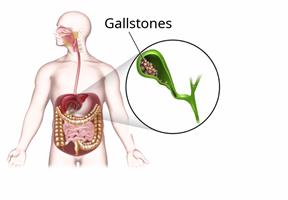Cholelithiasis

Cholelithiasis is a disease in which gallstones form in the gallbladder. The gallbladder is an organ that stores bile. Bile is a fluid that helps to digest fats. Gallstones begin as small crystals and can slowly grow into stones. They may cause no symptoms until they block the gallbladder duct, or cystic duct, when the gallbladder tightens, or contracts, after food is eaten. This can cause pain and is known as a gallbladder attack, or biliary colic.
There are two main types of gallstones:
Cholesterol stones. These are the most common type of gallstone. These stones are made of hardened cholesterol and are usually yellow-green in color.
Pigment stones. These are dark in color and are made of a red-yellow substance, called bilirubin,that forms when hemoglobin from red blood cells breaks down.
What are the causes?
This condition may be caused by too little or too much of the substances that are in bile. This can happen if the bile:
Has too much bilirubin. This can happen in certain blood diseases, such as sickle cell anemia.
Has too much cholesterol.
Does not have enough bile salts. These salts help the body absorb and digest fats.
It can also happen if the gallbladder is not emptying completely. This is common during pregnancy.
What increases the risk?
The following factors may make you more likely to develop this condition:
Being older than 40 years of age.
Eating a diet that is heavy in fried foods, fat, and refined carbohydrates, such as white bread and white rice.
Being female.
Having multiple pregnancies.
Using medicines that contain female hormones (estrogen) for a long time.
- Having certain medical problems, such as:
Diabetes mellitus.
Obesity.
Cystic fibrosis.
Crohn's disease.
Cirrhosis or other long-term (chronic) liver disease.
Certain blood diseases, such as sickle cell anemia or leukemia.
Having a family history of gallstones.
Losing weight quickly.
What are the signs or symptoms?
In many cases, having gallstones causes no symptoms. These are called silent gallstones. If a gallstone blocks your bile duct, it can cause a gallbladder attack. The main symptom of a gallbladder attack is sudden pain in the upper right part of the abdomen. The pain:
Usually comes at night or after eating.
Can last for one hour or more.
Can spread to your right shoulder, back, or chest.
Can feel like indigestion. This is discomfort, burning, or fullness in your upper abdomen.
If the bile duct is blocked for more than a few hours, it can cause an infection or inflammation of your gallbladder (
cholecystitis), liver, or pancreas. This can cause:
Nausea or vomiting.
Bloating.
Pain in your abdomen that lasts for 5 hours or longer.
Tenderness in your upper abdomen, often in the upper right section and under your rib cage.
Fever or chills.
Skin or the white parts of your eyes turning yellow (jaundice). This usually happens when a stone has blocked bile from passing through the bile duct.
Dark pee (urine) or light-colored poop (stools).
How is this diagnosed?
This condition may be diagnosed based on:
A physical exam.
Your medical history.
Ultrasound.
CT scan.
MRI.
You may also have other tests, including:
Blood tests to check for infection or inflammation.
The HIDA scan to see the gallbladder and the bile ducts.
An endoscope to check for blockage in the bile ducts.
How is this treated?
Treatment depends on the severity of your symptoms. Silent gallstones do not need treatment. You may need treatment if a blockage causes a gallbladder attack or other symptoms. Treatment may include:
- If symptoms are mild, you may care for yourself at home. For mild symptoms:
Stop eating and drinking for 12–24 hours. You may drink water and clear liquids. This helps to "cool down" your gallbladder. After 1 or 2 days, eat a diet of simple or clear foods, such as broths and crackers.
Take medicines for pain or nausea.
Take antibiotics if you have an infection.
- If symptoms are severe, you may:
Stay in the hospital for pain control or to treat severe infection.
Have surgery to remove the gallbladder (cholecystectomy). This is the most common treatment if all other treatments have not worked.
Take medicines to break up gallstones. Medicines may be used for up to 6–12 months.
Have an procedure to capture and remove gallstones.
Follow these instructions at home:
Medicines
-
Take over-the-counter and prescription medicines only as told by your health care provider.
-
If you were prescribed antibiotics, take them as told by your provider. Do not stop using the antibiotic even if you start to feel better.
-
Ask your provider if the medicine prescribed to you requires you to avoid driving or using machinery.
Eating and drinking
General instructions
-
Do not use any products that contain nicotine or tobacco. These products include cigarettes, chewing tobacco, and vaping devices, such as e-cigarettes. If you need help quitting, ask your provider.
-
Maintain a healthy weight.
-
Keep all follow-up visits. These may include seeing a specialist or a surgeon.
-
National Institute of Diabetes and Digestive and Kidney Diseases:
niddk.nih.gov
Contact a health care provider if:
-
You think you have had a gallbladder attack.
-
You have been diagnosed with silent gallstones and you develop indigestion or pain in your abdomen.
-
You have pain from a gallbladder attack that lasts for more than 2 hours.
-
You begin to have attacks more often.
-
You have nausea.
-
You have dark pee or light-colored poop.
-
You have pain in your abdomen that lasts for more than 5 hours or is getting worse.
-
You have a fever or chills.
-
You have vomiting that does not go away.
-
You develop jaundice.
This information is not intended to replace advice given to you by your health care provider. Make sure you discuss any questions you have with your health care provider.
